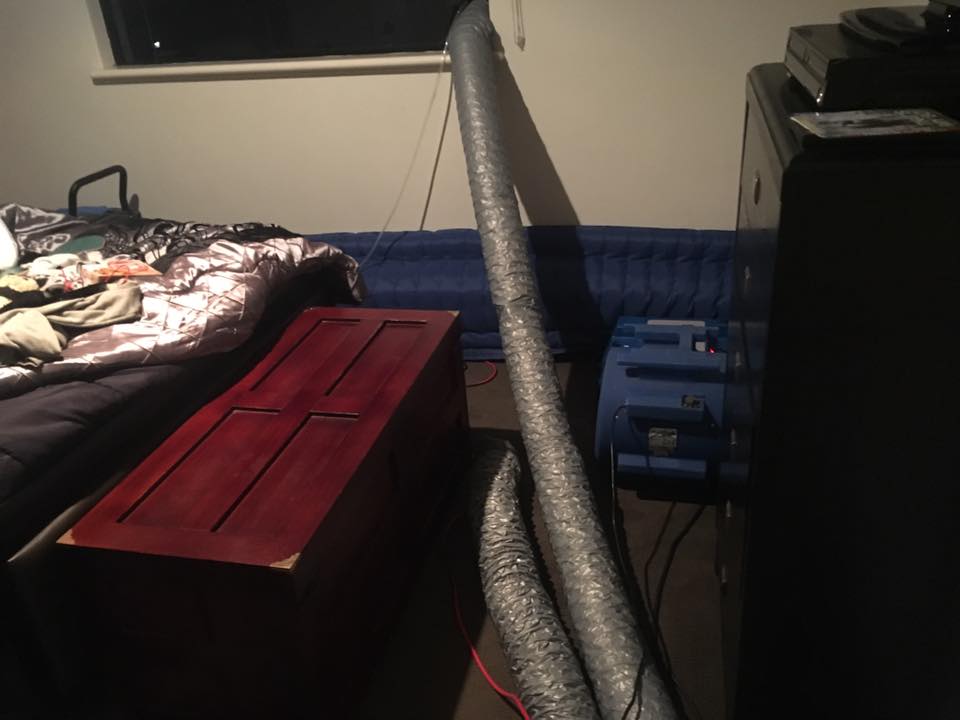Structural drying & mould remediation in Perth Yangebup - April Job of the Month.
Jonathan Kops from Spruce Up Your Home attended a flooding event where a dislodged roof tile and down into a brick cavity of a stairwell. This water then travelled along a steel girder at the base of the second story and entered into the internal structure damaging an MDF board connecting the internal first story structure to the second story structure. Water also travelled into the cavity of a second story neighbouring bedroom and leaked under the wall onto the carpet and MDF skirting board mouldings all of which required structural drying and mould remediation.
Complexities of the job included an expensive hardwood floor installed on the second story and mould that had started to grow on the MDF mouldings. To tackle this isolation of the rest of the structure from the drying and remediation environment was crucial as to not contaminate neighbouring areas and to not damage the expensive flooring. It would also save money on equipment and time to isolate the drying area to a small an area as possible.
After removal of all water damaged MDF mouldings it was discovered that structural drying only was required on a small section of the wall. The initial plan was to push air in at one side of the stairwell wall and pull air from the other side with the Drymatic II, however this quickly changed to just having to push and pull the air over a two meter square small area.
Great and Innovative Equipment Setup
Spruce Up fixed timber to the walls with wall plugs and screws to give themselves something to create their mould chamber with. They then used the same timber still fixed in place to create a miniature drying chamber and to also cover the exposed roof cavity.
Jonathan and his crew installed wooden beams above the MDF boards with wall plugs in the brick stairwell wall, that were used for multiple purposes:
The first of these were to isolate the stairwell for the purposes of mould remediation. Clear plastic sheeting that was attached and pulled across the top of the stairwell to isolate the second story from the stairwell.
After mould remediation, this same timber was used again to create a miniature drying environment by attaching the plastic further down the wall onto another timber frame installed onto the wall. Along the rest of the wall where the internal structure was exposed to the roof cavity, plastic was installed so, therefore, insulation, bugs critters, and dirt do not blow or crawl into the property before rebuilding commenced.
The Drymatic II took dehumidified air from the bedroom where a dehumidifier was installed, heats it up and blows it into the stairwell miniature enclosure. This air then gets recirculated and continually heated up until it holds an adequate amount moisture before getting blown out the window.
Jonathan chose to duct the wet air back out the window as he did not want the fully furnished bedroom to get too hot in order to prevent secondary damage. This also had the advantage of providing a cooler environment in which the dehumidifier could run most efficiently creating the low vapour pressure air being fed to the D2.
‘The boost box and dehumidifier part I think is pretty self-explanatory.” Jonathan told us. “The dehumidifier is lowering the vapour pressure of the air while the boost box is increasing the vapour pressure of the water contained in the walls. This is the sort of drying I need to undertake on most jobs, dense materials that require very significant vapour pressure differentials to get the water moving. Dehumidified air can only get you so far, material temperature is also an essential requirement in getting the vapour pressure differentials required to accelerate evaporation in these materials. With every extra degree of temperature, we can not only increase the diffusion rate of the material but also exponentially increase the vapour pressure of the bound water in the material."
Worked an absolute treat!
It was indeed a speedy Job
The drying equipment setup was Installed Thursday night and virtually dry Sunday night which is quick for a brick job. Jonathan left just the Drymatic II and Dehumidifier another day to let the stairwell wall drop another couple %. The plastic peeled back on the Monday to make sure there wasn’t any abnormally high spots that will make the customer report back and the equipment was removed from the site.
The customer was very satisfied with the Job
The client had suffered a water loss before on another property with no restoration team sent out. The course of action was to send someone with a pin meter in for week after week prodding of the wall saying it is still wet. The client had eventually had enough and took matters into her own hands by stripping back plaster herself to speed up the process. On another claim, a builder pulled out a mouldy ceiling and she found herself affected by the mould for weeks due to no isolation, negative pressure, proper cleaning or HEPA air scrubbing having taken place.
Jonathan Kops can be contacted on 0433565940 and connected with on his linkedin.
You can also find more about Spruce Up Your Home and their water restoration services on their site http://www.SpruceUp.com.au





